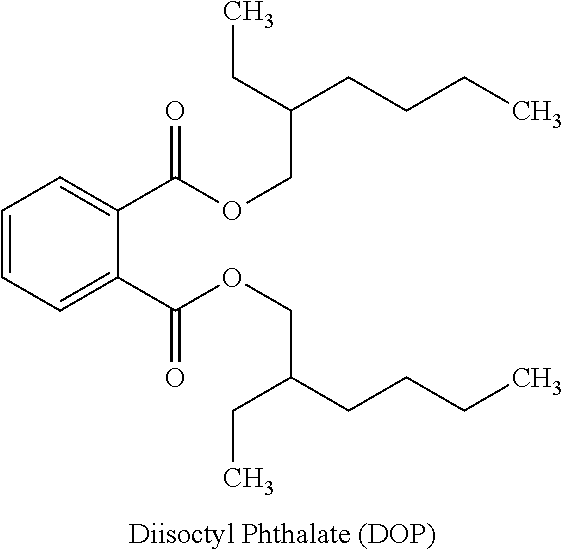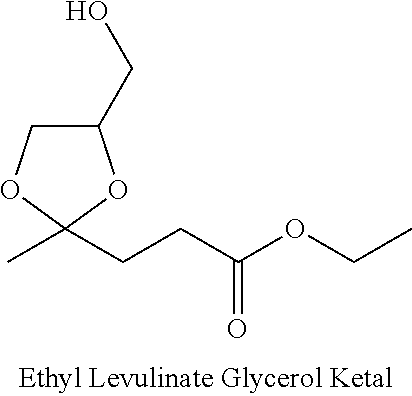Polymeric Plasticizer Compositions
a polymer and composition technology, applied in the field of polymer plasticizer compositions, can solve the problems of plasticizer loss, negative consequences of plasticizer loss from a polymeric material, and inability to fully integrate with and dissolve polymers,
- Summary
- Abstract
- Description
- Claims
- Application Information
AI Technical Summary
Benefits of technology
Problems solved by technology
Method used
Image
Examples
example 1
General Procedure for Preparation of Polymeric Plasticizer Compositions
[0178]The polymeric plasticizer compositions are made using the following general procedures.
[0179]Procedure When the Aromatic Acid Source is an Aromatic Diacid or Ester or Anhydride
[0180]The aromatic acid source, the glycol, and the C4-C36 monocarboxylic acid, or ester or anhydride thereof are charged into a 4 neck round bottom flask reactor and then the reactor is placed in a heating mantle that is connected to a temperature controller. A nitrogen gas inlet, a thermocouple, and a mechanical stirrer are connected to the reactor. The reaction is performed at 189-250° C. under nitrogen sparging conditions. When proper acidity is achieved by sampling and measuring the acid value, the reaction is terminated and characterized.
[0181]Procedure: Aromatic Polyester or Polycarbonate as an Aromatic Acid Source
[0182]A solid polymeric thermoplastic polyester such as PET is used as the acid source, for example PET or recycled...
example 2
Plasticized Polyvinyl Chloride Polymer Compositions
[0209]Using standard manufacturing techniques, plasticized polymeric compositions are made using the polymeric plasticizer compositions of the present invention and the desired polymer, for example a thermoplastic polymer.
[0210]The plasticized polymers can be used for example as a replacement for rubber, and have applications in areas including electrical cable insulation, flooring, coatings, tubing, inflatable products, and imitation leather.
[0211]The following formulation is an example of a plasticized polymer composition useful for wire and cable coatings.
[0212]Plasticized Polymer Formulation For Wire and Cable Applications
[0213]Polyvinylchloride (PVC) resin: 100 PHR
[0214]Polymeric Plasticizer of the Present Invention: 35 PHR
[0215]Additional Low Molecular Weight Plasticizers: 30 PHR
[0216]Ca / Zn: 4.5 PHR
[0217]Stearic acid: 0.2 PHR
[0218]Calcined Clay: 12 PHR
[0220]In the above formulation, PHR refers to par...
example 3
Plasticized Polyethylene Terephthalate (PET) Composition
[0234]PET pellets and Polymeric Plasticizer Composition 6 described in Example 1, 100 grams of each, were charged into a 500 mL 4-neck round bottom flask. The mixture was placed under a nitrogen atmosphere and stirred slowly with heating, at a temperature of 220° C., until the pellets completely dissolved. The temperature of the reaction mixture was cooled to 200° C. and poured into Teflon dishes to form an opaque, tan material.
TABLE 1Polymeric Plasticizer Composition PropertiesPolymeric Plasticizer Hydroxyl Number AverageComposition Acid ValueNumberViscosityMolecular WeightNo.(mg KOH / g)(mg KOH / g)(cP)(grams / mole)10.425.17648150020.521.516,203200032.031.919,316150041.819.622150052.517.128260061.612.55849150070.719.211,698200082.35.010,626150091.716.415,7311500100.614.717,4031500111.75.018101000120.526.541741000131.213.173,7841500143.911.428521000151.315.0811600161.238.96494500171.67.0348900180.551.28892650190.936.25099940201.930...
PUM
| Property | Measurement | Unit |
|---|---|---|
| acid value | aaaaa | aaaaa |
| acid value | aaaaa | aaaaa |
| temperature | aaaaa | aaaaa |
Abstract
Description
Claims
Application Information
 Login to View More
Login to View More - R&D
- Intellectual Property
- Life Sciences
- Materials
- Tech Scout
- Unparalleled Data Quality
- Higher Quality Content
- 60% Fewer Hallucinations
Browse by: Latest US Patents, China's latest patents, Technical Efficacy Thesaurus, Application Domain, Technology Topic, Popular Technical Reports.
© 2025 PatSnap. All rights reserved.Legal|Privacy policy|Modern Slavery Act Transparency Statement|Sitemap|About US| Contact US: help@patsnap.com



